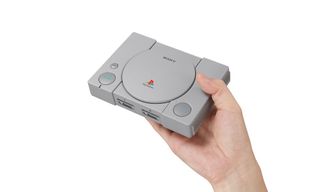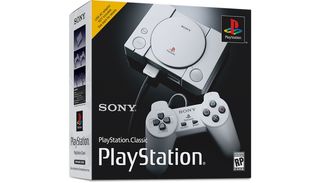Sony PlayStation Classic Unveiled: What Are the 20 Games?
Following on the steps of Nintendo and Sega, Sony will release a $100 re-edition of its first game console with two wired replica controllers and 20 games.
After Nintendo's raging NES Classic and SNES Classic success, Sega followed up with its now delayed Genesis Mini. Today, it’s Sony’s turn to jump into the nostalgia fever bandwagon with a $100 re-edition of its original console.

The CD-ROM-based Sony Playstation first came out in Japan on December 3, 1994. It took only a few months before becoming the No. 1 video game platform, crushing both Nintendo and Sega with 3D games never before seen in a home videogame platform.
The Sony Playstation Classic — as Sony calls it — comes with two controllers that are exact replicas of the originals down to the wire (yes, they are not wireless to keep costs down).
MORE: Marvel's Spider-Man Review: Finally, the Spidey Game We Deserve
The console is 45 percent the size of the original and connects to your TV using an HDMI port, sucking its power out of micro-USB, not a regular power cable.
It will repurpose its “Reset” button as a way to pause games and save their status so can restart playing just exactly where you left things, like the Nintendo retro consoles.
The open CD tray button is also repurposed: it will allow you to change the games you want to play, which are all stored in memory. Like the NES or the SNES — which don’t use cartridges — the Sony Playstation Classic will not have a CD-ROM but will come pre-loaded with 20 classic games.
Sign up to get the BEST of Tom’s Guide direct to your inbox.
Upgrade your life with a daily dose of the biggest tech news, lifestyle hacks and our curated analysis. Be the first to know about cutting-edge gadgets and the hottest deals.
The Big Question: What are the 20 games?
According to the company, the 20 games will vary depending on the country, just like the original Playstation games were limited by region. In theory, and presumably thanks to copyright and licensing issues, this means that European Playstation Classics will get 20 different games than the American and Japanese versions.

We only know that there’s already five games in the list: Ridge Racer Type 4, Final Fantasy VII, Jumping Flash (weird that it included this one), Wild Arms, and Tekken 3. Which, OK I guess. FFVII is certainly a must. And you can argue that Tekken 3 is, too.
But that’s exactly the problem: the original Playstation is so gigantic and has such good quality that it just seems impossible that this console will please anyone. The NES, with its 30 built-in games, and the SNES, with 21, have a good catalog that seem to have satisfied everyone.
MORE: The Best Open-World Games on PS4, Xbox One and Switch
There are the two first games that made the console a raging success: the excellent Battle Arena Toshinden (which I guess will not appear, since it already has Tekken 3) and the first Ridge Racer (which presumably will be replaced by Ridge Racer Type 4).

Then there’s the catalog of some of the very best games in the history of gaming. They already got down Final Fantasy VII, but if Sony wants to make any sense out of this piece of plastic and metal, it needs to include Metal Gear Solid, Driver, Resident Evil 2, Gran Turismo 2, Crash Bandicoot. Oddworld, Street Fighter, Spyro the Dragon, Castlevania: Symphony of the Night, One, Parasite Eve II, Tomb Raider, that quirky gem called PaRappa the Rapper, and the funnest future racing game: Wipeout.
The list can go on and on. The original Playstation was so successful that you can probably fill three of these classic re-editions with some of the best games of their generation. I’m sure that each and every reader of these lines will have their own list of 30 or 40 games they would like to see in this hardware.
To know the final list we will have to wait December 3, where the Sony Playstation Classic will be released in the US, Canada, Europe, Japan an Australia. It will set you back $100 in the US and 100 euro in Europe. Get ready to click “BUY” like crazy in Amazon, because these are going to fly.
Jesus Diaz founded the new Sploid for Gawker Media after seven years working at Gizmodo, where he helmed the lost-in-a-bar iPhone 4 story and wrote old angry man rants, among other things. He's a creative director, screenwriter, and producer at The Magic Sauce, and currently writes for Fast Company and Tom's Guide.

